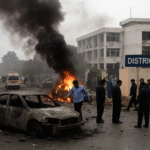Abstract
In November 2025, Pakistan introduced its Sufra / SAFRAH jamming gun, an indigenous Pakistan anti-drone system designed to counter explosive mini-UAVs, illegal cross-border smuggling drones, and tactical surveillance platforms. This modern counter-UAV Pakistan solution was showcased as part of the NECOP Sufra 2025 technology line-up. With an estimated 1.5 km effective range and precise directional coverage, it aims to support Pakistan’s kamikaze drone defence and internal security posture against evolving aerial threats.
Background and technical snapshot
The rapid spread of commercial drones ranging from hobby-grade quadcopters to improvised kamikaze strike UAVs has made drone jamming technology a core requirement for modern militaries. Criminal networks increasingly deploy UAVs for drone smuggling interdiction, particularly across sensitive border belts. Meanwhile, militants in various global theatres have used FPV and small kamikaze drones with devastating effect.
To address such threats, the National Electronics Complex of Pakistan (NECOP) unveiled the Sufra jamming gun under the NECOP Sufra 2025 defence showcase. The system uses electronically directed radio-frequency jamming to sever drone control links, disrupt GNSS signals, and force hostile drones into fail-safe modes such as autoland or return-to-home.
With a lightweight body, shoulder-mounted design, and a claimed ability to operate for multiple engagements per battery cycle, it reflects Pakistan’s intent to bring effective electronic warfare jamming gun solutions into mainstream defence planning.
Operational roles and deployment concepts
The Sufra unit is engineered for anti-drone tactics Pakistan forces can use in real, on-ground scenarios rather than lab-only demonstrations. Key employment environments include:
• Military and naval bases: Close-proximity perimeter defence, especially where kamikaze drones or quadcopters may try to approach runways, ammunition depots or naval docks.
• Public and VIP events: Stadiums, religious events and political gatherings now require layered kamikaze drone defence as unmanned threats evolve.
• Forward border posts: Ideal for patrol units on India and Afghanistan frontiers involved in drone smuggling interdiction missions.
• Urban counter-terror operations: Disrupting hostile surveillance drones during raids to deny militants real-time situational awareness.
Importantly, this jammer works best inside a layered C-UAV architecture, where radar, EO/IR cameras and acoustic sensors form a detection chain followed by selective non-kinetic defeat.
Strategic value and industrial implications
Sufra represents more than a single device; it signals Pakistan’s maturing indigenous defence-tech culture. For years, the country relied heavily on imported anti-drone solutions. Now, domestic production under NECOP Sufra 2025 improves sustainability, sovereignty and customization.
Strategically, the system strengthens Pakistan’s counter-UAV Pakistan toolkit at a time when low-cost drone warfare is becoming a decisive factor on battlefields. From Ukraine to Gaza, small suicide drones have changed the calculus of close-quarters combat. Sufra gives Pakistan a kamikaze drone defence instrument that can evolve locally through firmware upgrades and new frequency packages.
Industrially, the project supports Pakistan anti-drone system capability-building and encourages the local tech base an essential step toward future high-power EW platforms, integrated bases, and export potential.
Limitations and operational challenges
Despite its promise, Sufra is not a silver bullet. The device faces challenges:
1. Range limitation: A 1.5 km envelope is practical for facilities and patrols but cannot fully secure wide border belts or high-altitude UAV operations.
2. Autonomous threats: Fully autonomous drones or encrypted frequency-hopping systems may reduce jammer effectiveness, particularly in advanced swarm attacks.
3. Signal environment sensitivity: Urban RF congestion demands careful planning to avoid civilian interference during deployment.
4. Evolving adversary tactics: Smuggling rings and militant groups rapidly adapt to jamming patterns, necessitating continuous EW upgrades.
However, these challenges are normal for any electronic warfare jamming gun and reinforce the need for innovation, doctrine refinement and layered defence integration.
Recommendations for force integration and capability development
1. Integrate into layered C-UAV architecture: Combine with radar, RF-direction finders and visual systems. Jammers alone are not a detection tool.
2. Scale production: Deploy widely across police, Rangers, FC, and aviation security units—especially coastal, border and strategic infrastructure zones.
3. Doctrine & training: Build specialised anti-drone tactics Pakistan courses with SWAT, military police, and border security.
4. Hardware upgrades: Shift toward software-defined radios (SDRs), modular frequency packs and directional antennas for military-class targets.
5. Legal framework: Structured operational and spectrum-usage rules to minimise civilian signal disruption.
Conclusion
Sufra / SAFRAH is a serious, timely response to a real threat. It offers Pakistan a counter-UAV Pakistan asset that is locally produced, tactically flexible, and scalable for national security forces. Whether used for drone smuggling interdiction, base security, VIP protection or kamikaze drone defence, it represents a meaningful step in modernising Pakistan’s defensive toolkit.
The future success of this Pakistan anti-drone system depends on doctrinal adoption, industrial commitment and continuous refinement. If executed correctly, the NECOP Sufra 2025 programme may lay the foundation for a broader national electronic warfare ecosystem.
Frequently Asked Questions (FAQ)
Q: Does Sufra physically shoot drones down?
No. It is a drone jamming technology tool. It disables drones electronically, forcing them to land or lose control.
Q: Is it effective against military UCAVs?
It is primarily designed for commercial-class and modified kamikaze drones. Military-grade satellite-linked systems require heavier EW assets.
Q: Can it handle drone swarms?
A single jammer cannot neutralize a complex swarm. Coordinated jamming and kinetic tools are required.
Q: Will the jammer interfere with civilian signals?
Proper frequency control and authorised deployment zones minimise disruption.
Q: Who will use it?
Military, Rangers, FC, intelligence security elements, airport forces, and police special units.










